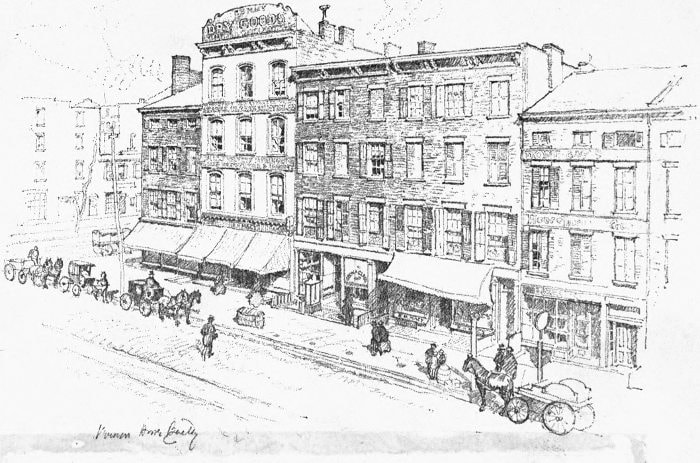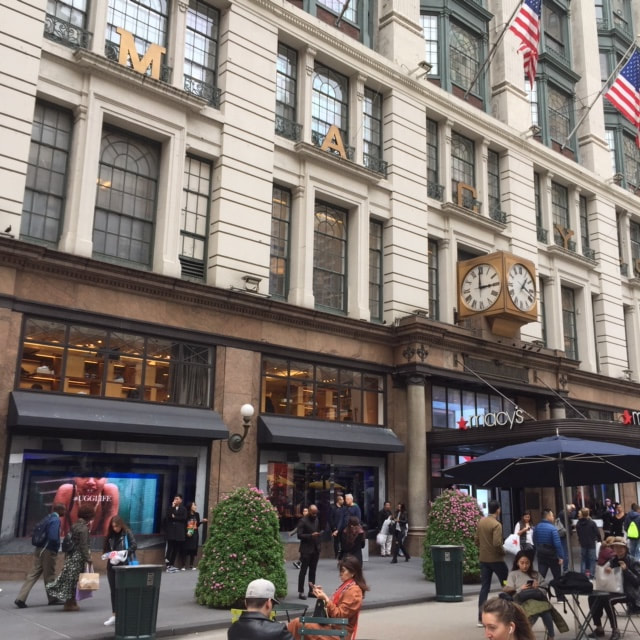|
By Laurie Lewis At the end of this month, on Thanksgiving, all eyes will turn to the Macy’s at Herald Square, where the annual televised parade ends with the arrival of Santa Claus. Few parade-watchers know the backstory of Macy’s. After reading this, you will be among the informed. The man behind the store was Rowland Hussey Macy. He sailed on a whaling ship as a teenager before deciding the sea life was not for him. Wanderlust must have been in his veins, however, because he moved around--to California, Wisconsin, and back to his home state of Massachusetts--trying unsuccessfully to establish a dry goods business. Then he relocated to New York City, where he tried again. He opened a small store bearing his name on Sixth Avenue and 14th Street in 1858, ringing up all of $11.06 on the first day. Business quickly picked up, and his first-year sales totaled about $85,000. By the time Macy died in 1877, the shop had expanded into a full-fledged department store taking up eleven adjacent buildings. Macy's (the tallest building) in 1858, at its original location on Sixth Avenue. Illustration by Vernon Howe Bailey, 1922. Early on, Macy’s had a logo: a red star. It was a replica of a tattoo Macy had gotten as a young seaman. The star remains the emblem of the giant retailer. Once he found his footing in Manhattan, Macy turned out to be an innovator in retailing. Instead of haggling with clerks, customers knew exactly what an item cost, because they saw the price in newspaper advertisements and on merchandise tags. To attract customers, Macy’s showcased goods in lit window displays. The first department-store Santa debuted at Macy’s in 1862. The store sold colored bath towels, a novelty at the time. Knowing customers might want a refreshment break, Macy obtained a liquor license and also set up a soda fountain in a location where shoppers had to pass through several departments to reach. Many of these ideas came from Margaret Getchell, the first woman to be promoted to an executive position in retail (see “The Woman Behind the Scenes,” below). Several years before his death, Macy had arranged for Nathan and Isidor Straus to sell china and glassware in his store. The Straus brothers took over management of Macy’s when the founder died. The Macy’s brand was so well established that they continued to operate the store under that name. By the turn of the century, the store had outgrown its space, and the customer base was inching further north. In 1902 Macy’s relocated too, to its flagship store at Herald Square. Macy’s expanded to fill an entire square block in 1924, earning it the moniker of “the world’s largest store.” It still is America’s largest, but South Korea has had a bigger retailer, Shinsegae, since 2009. Macy's today, at Herald Square. Note the red star on the awning. On Christmas Day 1924, employees put on a big show: the first Macy’s parade. It featured clowns and live animals from the Central Park Zoo. Three years later, huge balloons replaced the animals. The parade ended then, as it does now, with the arrival of Santa Claus. The parade now takes place on Thanksgiving instead of Christmas, and Santa’s appearance signals the start rather than the end of the holiday shopping season. What better place to shop than at the parade’s sponsor, Macy’s? The Woman Behind the Scenes In 1861, Margaret Getchell moved to New York City from Nantucket and took an entry-level position at a three-year-old store, Macy’s. A whiz with numbers, she was soon promoted to bookkeeper. She often shared her ideas with her boss, R. H. Macy himself, and he was so impressed that he promoted her again to superintendent, an executive position—an unheard of slot for a woman in those days. It was Margaret Getchell who suggested that the store expand its inventory and sell ready-made clothes, jewelry, toiletries, and household goods. The soda fountain was her idea too. By 1869, Getchell oversaw 200 employees, who racked up $1 million in sales a year. Getchell married a Macy’s employee, and they lived in rooms above the store. When her husband was promoted to partner, she was asked to give up her salary. A company woman to the end, she continued to work for Macy’s without pay while raising a family. She even ran the store for several months—while pregnant and not collecting a salary—when her husband and Macy were on a European buying trip. That is probably something that no woman would do today. November Tours Most Take a Walk New York tours cover 1 to 2 miles, last 2 to 2½ hours, and cost $25 per person. Advance registration is required. To register and to learn the meeting place, email the guide ([email protected] or [email protected]). Please arrive a little before the start time. Tours are cancelled if nobody has registered or if the weather is extreme; if in doubt, call or text Laurie (917-306-2868) or Alan (917-363-4292). Fort Tryon Park The high ground in Upper Manhattan that appealed to the new American army for a defensive fort later attracted millionaires who wanted to build castles on the Hudson. We’ll walk from the site of Fort Washington to Fort Tryon Park, exploring vestiges of a Gilded Age estate. We’ll take in the Heather Garden and the park’s extraordinary Hudson River views. You’ll hear about a fearless woman who was a good shot with a cannon, a self-indulgent tycoon, and a very generous Rockefeller. We’ll end at the Cloisters Museum, which you may want to visit on your own. Alan leads this 90-minute tour on Wednesday, November 6, at 10 AM. To make a reservation and to learn the meeting location, please email him at [email protected]. Central Park: Marvels of the Northern Half The northern end of Central Park features some of the city’s most surprising landscapes. We may be lucky and still see spectacular fall colors. We'll enjoy a hike in the woods, and discover New York’s own Secret Garden. If history rather than nature is your thing, fear not. You’ll learn about the role this area played in early American wars. Because this is our favorite part of Central Park and fall is the best time here, we offer this tour twice this month. Join Laurie on Friday, November 8, at 11 AM or Alan on Wednesday, November 20, at 10 AM to explore the northern part of Central Park. Please email the guide to reserve a spot and to learn where to meet. Hidden Treasures of the Financial District Walking through the canyons of Wall Street, you can easily miss gems hidden in plain sight, including relics of the Dutch and English colonial periods and park-like oases. Discover these secrets while seeing major attractions like the New York Stock Exchange and the Charging Bull statue. You’ll realize that the Financial District has a lot more going for it than stock trades and megadeals. Laurie offers this tour on Sunday, November 17, at 1 PM. To reserve a spot on the tour and to learn the meeting location, email her at [email protected]. Lower Washington Heights Washington Heights is a microcosm of New York, steeped in history from the American Revolution to the assassination of Malcolm X and beyond. Discover the Hamilton connection in northern Manhattan. This vibrant residential neighborhood boasts beautiful brownstones, a brick-lined street with three-story wood-frame homes, and the oldest house in Manhattan. Join Alan on Wednesday, November 27, at 10 AM to take a walk through Lower Washington Heights. Please email him ([email protected]) to reserve your space and to learn the meeting location. November Tours
Comments are closed.
|
Archives
April 2024
|



